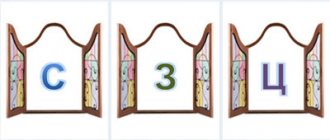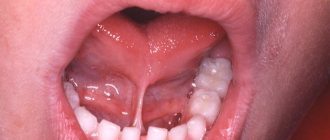Classification
In domestic speech therapy, distortion of sounds is classified as phonetic (motor, anthropophonic) defects, in which the sound structure is modified. Unlike substitution or absence of phonemes, distortion is not physiological and does not go away on its own. There are several types and many subtypes of sound distortion. They are designated by terms derived from the corresponding Greek letters:
- Rotacism
(burr) is a defective pronunciation of the sound [P] and its soft pair [P′]. - Sigmatism
(lisp) is a distortion of whistling sounds ([S-S′], [Z-Z′], [C]) and hissing sounds ([Ш], [Ш], [Х], [Ч]). - Lambdacism
is the incorrect pronunciation of sounds [L-L′]. - Yotacism
- non-normative articulation of the sound [Y]; - Defects in the articulation of posterior palatal sounds:
gammacism - distortion [Г-Г′], kappacism - [К-К′], hitism - [Х-Х′].
With speech disorders, sounds of various groups are often distorted, i.e., there are polymorphic defects: rhotacism + sigmatism, rotacism + lambdacism, sibilant sigmatism + back-lingual defects, etc. Statistically, the pronunciation of anterior-lingual fricatives (hissing and whistling) is distorted more often, – back- and middle-lingual. According to their speech therapy status, children with distortion of sounds can belong to the group of FN, FFN or ONR.
What is distortion in music? When and how to use it?
Music creation software has audio volume limits. If the audio signal exceeds these limits, it will become distorted and produce a harsh, loud, unpleasant sound that causes most people to cover their ears.
Unwanted distortion negatively affects the quality of the mix. But it also has many musical applications when introduced intentionally and carefully. Distortion improves the sound of synths and guitars, adds energy and punch to drums, and gives dull sounds the right vibe.
We are in the prime of life for distortion as both a musical and aesthetic effect. Strong house and hip-hop tracks with the "lo-fi" tag attached are riding a big wave of blog buzz. DIY labels produce cassette tapes. Even pop singers use distortion.
In this article, I'll show you how to creatively use distortion in your DAW, along with audio examples.
Types of distortion and their sources
Distortion can occur during the recording, production, and “engineering” stages of a song. Here are just a few examples of how unwanted distortions can occur:
Impedance mismatch occurs when the impedance (measured in ohms) of an output signal—such as a guitar—produces a signal that has a high impedance value compared to the impedance value of the microphone input, such as on an audio interface or mixer. A high impedance output produces very distorted sound from an input that is not designed to accept high impedance signals. The result is usually a distorted tone and unwanted noise in the signal.
Clipping is a type of distortion that most often occurs when the input or output signal is exceeded, which I will discuss in detail below.
Truncation is caused by bits being reset when playing or rendering an audio signal, which can result in a low-level, distorted signal.
Now let's get back to clipping. Digital and analog distortion occurs when the audio signal passes through the system's maximum power level, which in a DAW is typically 0 dBFS (decibel full scale). With clipping, you lose portions of the signal above the 0 dBFS threshold, cutting off the signal.
Digital distortion occurs when the audio signal goes beyond the DAW's maximum power, which is typically 0 dB in a DAW. To continue playback, the DAW will compress portions of the signal above the distortion threshold, cutting off the waveform.
Distortion of a sine wave in a DAW captured by an oscilloscope.
Sine wave with distortion (distortion)
As the sine wave is distorted, it begins to sound closer to a square wave. This new harmonic information increases the perceived loudness of the signal.
The peak level in the sine wave may not change on the counter when the distortion threshold is reached (although the oversampling counters will), but the level of the newly distorted signal will change during playback and appear louder. So how can this be used in a more creative, musical way? Let's find out.
Film saturation (Feathering). Film distortion
When digital technology was introduced as a means of music production, many complained that it lacked the warmth and character of analog technology. To some extent this is true. As you heard above, digital distortion can be harsh. But when tape is overloaded with an audio signal, it creates a rich, harmonically controlled distortion called saturation.
These days we can reproduce analog saturation in our DAWs with plugins like Tape Machine and others. Saturation can be used effectively on almost any element of a mix, but it is perhaps most satisfying when applied to drums. Listen to these drums without saturation.
Dry drum break
The groove is there and the beats sound pretty strong too. But the percussion and the worker could use some “loading.” So I used the Ozone 8 Advanced Vintage Tape “Clean Fifteen” preset to warm up the mids and highs.
Warm up your drums with Vintage Tape
Breaking drums with the “Clean 15” preset
Here Tape Machine adds clarity and fills the empty space between each beat. Despite the fact that the drums are equipped with a modern sound selection and placement system, they “feel” like analog sound. In your own DAW, you can emphasize lows, highs, and harmonics to suit your style.
Be careful when applying saturation to hi-hats, cymbals, claves, and bells. These sounds are already rich in high-frequency components and will become rougher and harsher with the addition or amplification of harmonics.
Warm to abrasive
If you think an element of the mix sounds boring and could benefit from some added harmonics, run a distortion plugin like Trash 2. This goes beyond subtle saturation and really allows for artful use of distortion. The plugin has two stages of distortion processing, each with its own curve and drive settings. It also includes a filter and built-in delay.
As a general rule, you always want to work with high quality samples and recordings. Distortion improves sound in many cases, but usually degrades low quality sound. Since most synthesizers include mostly mid- and high-range content, distortion is most effective when adding brightness and shimmering sounds.
I'll be working with this background "pad" in the style of Brian Eno.
Dry background pad
I specifically want to improve the treble, so I turned on Trash 2's multiband mode and increased the drive for the 4-10kHz custom frequency range.
Background pad with Trash 2 multi-band mode
Warm up your drums with Vintage Tape
The airiness of the pad is emphasized, as well as the pleasant rough texture.
As you increase the distortion drive, your synth will begin to sing or even scream as the timbre changes.
Background pad with Trash 2, increased distortion drive
Drive will increase the amplitude of your signal and make your mix louder. Monitor Trash 2's output to ensure the volume is the same before and after distortion. Switch the plugin bypass to check this. Just because your mix is loud doesn't mean it's full.
Paired with low-frequency audio (also passed through Trash 2), we get more dynamic cleanup of the sound.
Background pad with Trash 2 & Bass
There are countless processing options in Trash 2, so I encourage you to explore the plugin to find the presets you like.
The future of distortion
In this article, I showed you how to use distortion on drums and synths. But you don't have to stop there. Use distortion to tone down bass, add texture to vocals, and transform guitars. But remember - there is such a thing as too much distortion! This can easily overpower other elements of the mix or ruin your mix overall. Start with low dry or rich sound and drive settings, then slowly raise them until you hear a noticeable difference. Explore distortion with Vintage Tape in Ozone 8 Advanced and Trash 2.
translation of the article from English was carried out by the production studio based on materials from the site: https://www.izotope.com/
Find out how much it will cost to mix your track
Causes of sound distortion
Distorted sound pronunciation, as a rule, is based on anatomical deviations in the structure of the peripheral organs of articulation or their functional immaturity. As a result, compensatory articulatory patterns are formed that do not provide the acoustic norm. The distorted sounds only vaguely resemble the correct speech pattern.
Bilingualism
Distortion of the sounds of the Russian language is typical for speakers of other language systems. Thus, for French phonetics, the norm is the burry pronunciation [r], for English - the interdental pronunciation of the diphthong
. Such borrowings are often found in the speech of bilinguals. At the same time, for the Russian language such distortions are phonetic errors.Dislalia
Phoneme distortion occurs in both functional and organic dyslalia, but has different developmental mechanisms. Functional tongue-tiedness is associated with sluggish speech motor skills, imitation of defective speech of others, etc. Mechanical dyslalia can be caused by a shortened hyoid ligament, a large sluggish tongue (macroglossia) or a small narrow tongue (microglossia), a high (“Gothic”) vault of the palate, diastemas, anomalies bite
Distortions of sounds due to anomalies of the dentofacial system are often represented by various types of sigmatism, defects in anterior lingual and labiodental sounds. The air stream comes out through the gaps between the teeth. Whistling and hissing sounds become excessively noisy, with a squelching tint; vowels are barely intelligible.
With anomalies and weakness of the muscles of the tongue, vibrants and sibilants are usually impaired, and lateral sigmatism of sibilants is noted. Pronunciation may become slurred. Inadequate lip closure causes distortion of labial and labiodental sounds. Possible defective articulation of labialized vowels ([О], [У]).
In all cases, with dyslalia, only impaired sound pronunciation is noted. Other components of speech (voice, prosody, vocabulary and grammar, vocabulary diversity) remain intact.
Distortion of sounds
Dysarthria
Numerous distortions of sounds in dysarthria are caused by innervation insufficiency of the speech apparatus. As a result of weakness of the articulatory muscles, sounds are pronounced inaccurately. The movements of the tip of the tongue are poorly differentiated, which is why the anterior lingual ones are distorted to the greatest extent: various variants of sigmatism, rhotacism, and lambdacism arise.
In this case, the greatest difficulty is presented by whistling sounds, followed by hissing sounds, and sonorous sounds are disturbed to a lesser extent. Iotized and back-lingual ones practically do not suffer. Distortion of sounds in most cases occurs according to the type of lateral and interdental pronunciation.
The tension of the lip muscles affects the pronunciation of labial consonants and labialized vowels. There are defects in voicing and deafening, and excessive palatalization. Speech is slurred and poorly intelligible. The process of automating the delivered sounds is extremely difficult and takes a long time.
In addition to distortion of sound pronunciation, voice changes (weakness, monotony, hoarseness, rhinophony) are typical for dysarthria. Swallowing is often impaired and hypersalivation is noted. General motor skills suffer to one degree or another; differentiated movements of the fingers cause particular difficulties.
Rhinolalia
Open rhinolalia occurs due to congenital facial clefts (cleft palate, cleft lip). With this pathology, all vowels and consonants have a nasal tint, a snoring sound, and are poorly differentiated by ear. Front-lingual and posterior-lingual consonants are especially difficult. Voiceless consonants are more reminiscent of the nasalized sound [X], while voiced consonants are more reminiscent of the sound combination [KG]. Thus, distortion of sounds is the primary speech defect in rhinolalia. Secondarily, phonemic, lexico-grammatical processes and written speech may be disrupted.
Causes of functional dyslalia
Somatic Physical and neurological weakness due to long-term chronic diseases of the body (indigestion, frequent colds) Social
- Pedagogical neglect (parents do not correct deficiencies in their children’s speech and do not demonstrate examples of correct sound pronunciation).
- Bilingualism in the family (When parents speak different languages, the child inserts another into one language. For example, French + Russian = throat sound “R”).
- A sample of incorrect speech in a child’s environment (by imitation).
Incorrect articulation Selecting incorrect articulation Underdevelopment of phonemic hearing Physical hearing can be preserved, but phonemic hearing is impaired.
Diagnostics
Features of speech function are studied by a speech therapist during an individual examination. For certain nosologies, dental and neurological diagnostics are indicated. Speech therapy diagnostics includes several successive stages:
- Examination of articulation organs.
The structure of the peripheral speech organs (lips, teeth, jaws, tongue, palate) and their mobility are studied. To do this, a visual inspection is performed and a series of dynamic exercises are performed. In the presence of certain anatomical defects and functional deviations, we can assume certain speech disorders in the subject. - Diagnostics of oral speech.
The main focus is on the pronunciation of sounds. Phonetic (distortion) and phonemic deficiencies (confusion, substitutions), and violations of syllabic structure are identified. The formation of phonemic functions, coherent speech, and the lexico-grammatical structure of the language is also examined.
Disadvantages of pronunciation of individual sounds
| Defective sound | Phonetic defect (sound distortion) | Phonemic defect (confusion, sound replacement) | ||
| Name of pronunciation defect | Types of defective pronunciation | Name of pronunciation defect | Types of substitutions | |
| Sound R | Rotacism | Velar, uvular, lateral, buccal, single-impact, “coachman” | Pararotacism | Р = Р' Р = Л' Р = J Р = Г Р =Д |
| Sound L Sound L' | Lambdacism | Bilabial, softened | Paralambdacism | L = Y L = G L = L' L = R |
| Sounds S, S' Sounds Z, Z' Sound C | Sigmatism | Interdental, labial-dental, lateral, subdental, sibilant | Parasigmatism | S, Z, C = W S, Z, C = F S, Z, C = T S, Z, C = Shch S - W; C = H |
| Sound Ш Sound Ж Sound Ш Sound Ш | Sigmatism | Mesdental, buccal, lateral, “lower”, posterior lingual, softened, shortened, affricative | Parasigmatism | Sh, Zh, Shch = T Sh, Zh, Shch = F Zh = Sh Zh = Z Shch = S' Sh = Shch Ch = T'; Ch = Sh' |
| Sound j | Yotacism | Soft lower and upper articulation | Paraiotacism | J = L' |
| Sounds K, K | Kappacism | Vocal, laryngeal | Paracapacism | K = T |
| Sounds G, G | Gammacism | Fricative velar, pharyngeal | Paragammatism | G = T |
| Sounds X, X | Hitism | Vocal, laryngeal | Parachytism | |
Correction
Speech therapy work
The correctional and pedagogical complex for distortion of sounds caused by dyslalia and dysarthria is implemented in three stages. Each of them has its own goals and objectives and is carried out using specialized methods and techniques:
- Preliminary stage.
The main directions are the preparation of the articulatory base, the development of precise articulatory patterns, the development of auditory memory and attention. During this period, articulation gymnastics, exercises to develop an air stream, logomassage, and games for the development of fine motor skills are performed. - Formation of correct sound pronunciation.
Sound production can be done imitatively, with the help of special speech therapy devices (probes, probe substitutes, auxiliary devices) or in a mixed way. Subsequently, sound pronunciation is automated in isolation, in syllables and syllabic rows, in different positions in a word, in phrases, sentences, and texts. - Consolidation of the received sound in speech.
At the final stage, the skill of using a new sound is practiced in various communicative situations. Conscious self-control of speech is exercised.
For rhinolalia, correctional speech therapy work has its own characteristics and is carried out in the preoperative and postoperative periods. Before the operation, sound production of phonemes accessible by articulation, development of voice and speech breathing, and special massage are carried out. After the operation, all other distorted sounds are staged and automated, speech therapy massage of the palate continues, work is being done on the formation of velopharyngeal closure, and nasalization is eliminated.
Correction of distorted pronunciation of zouks
Medical direction
Speech therapy correction of sound distortion in dentofacial and maxillofacial anomalies is carried out against the background of orthodontic and surgical treatment. If the frenulum of the tongue cannot be stretched using speech therapy exercises, frenuloplasty is performed. If your bite is incorrect, you may need to wear orthodontic appliances or perform orthognathic surgery.
Patients with open rhinolalia undergo surgical correction of facial deformities: cheiloplasty, uranoplasty, velopharyngoplasty. Dysarthric disorders require regular courses of drug treatment and physiotherapeutic rehabilitation (physical therapy, Bobath therapy, massage using the Castillo Morales method, etc.).








